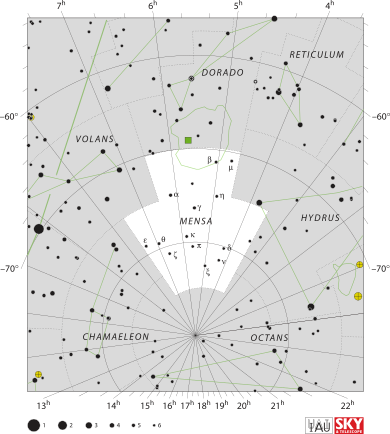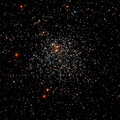Mensa (constellation) facts for kids
| Constellation | |

List of stars in Mensa
|
|
| Abbreviation | Men |
|---|---|
| Genitive | Mensae |
| Pronunciation | genitive: |
| Symbolism | the Table Mountain |
| Right ascension | 4 ~ 7.5 |
| Declination | −71 ~ −85.5 |
| Quadrant | SQ1 |
| Area | 153 sq. deg. (75th) |
| Main stars | 4 |
| Bayer/Flamsteed stars |
16 |
| Stars with planets | 2 |
| Stars brighter than 3.00m | none |
| Stars within 10.00 pc (32.62 ly) | none |
| Brightest star | α Men (5.09m) |
| Messier objects | none |
| Meteor showers | none |
| Bordering constellations |
Chamaeleon Dorado Hydrus Octans Volans |
| Visible at latitudes between +4° and −90°. Best visible at 21:00 (9 p.m.) during the month of January. |
|
Mensa is a constellation found in the southern part of the night sky. A constellation is a group of stars that form a pattern. People often imagine these patterns as objects, animals, or people. Mensa is one of the 88 modern constellations. It is quite small and not very bright.
Contents
What is the Mensa Constellation?
Mensa is a constellation that you can only see from the Southern Hemisphere. It is located very close to the South Celestial Pole. This means it is always visible for observers in far southern locations.
Who Named Mensa?
The constellation Mensa was named by a French astronomer named Nicolas-Louis de Lacaille. He created this constellation in the 1750s. Lacaille named many constellations during his time observing the sky from South Africa.
What Does Mensa Mean?
The name "Mensa" comes from the Latin word for "table." Lacaille named it after Table Mountain in Cape Town, South Africa. This mountain has a very flat top, like a table. He thought the constellation looked like a table in the sky.
Stars in Mensa
Mensa is known for not having any very bright stars. This makes it a bit tricky to spot in the night sky.
Alpha Mensae: The Brightest Star
The brightest star in Mensa is called Alpha Mensae. Even though it's the brightest, you would need a dark sky to see it. It's not as bright as many other well-known stars. Alpha Mensae is about 33 light-years away from Earth.
Other Stars and Planets
While Mensa doesn't have many bright stars, some of its stars are known to have planets orbiting them. Scientists use special telescopes to find these distant worlds. Finding planets around other stars helps us learn more about the universe.
Finding Mensa in the Sky
Because Mensa is faint, it's best to look for it on a clear, dark night. You can find it near other southern constellations. These include Chamaeleon, Dorado, and Octans. Octans is important because it contains the South Celestial Pole.
Images for kids
-
NGC 1987 imaged by the Hubble Space Telescope
See also
 In Spanish: Mensa (constelación) para niños
In Spanish: Mensa (constelación) para niños


